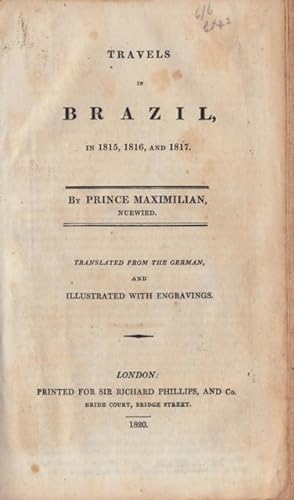MAXIMILIAN, PRINCE, OF NUEWIED (1 résultats)
Type d'article
- Tous les types d'articles
- Livres (1)
- Magazines & Périodiques
- Bandes dessinées
- Partitions de musique
- Art, Affiches et Gravures
- Photographies
- Cartes
-
Manuscrits &
Papiers anciens
Etat
- Tous
- Neuf
- Ancien ou d'occasion
Reliure
- Toutes
- Couverture rigide
- Couverture souple
Particularités
- Edition originale
- Signé
- Jaquette
- Avec images
- Sans impression à la demande
Pays
Evaluation du vendeur
-
TRAVELS IN BRAZIL IN 1815, 1816, AND 1817: Translated from the German and Illustrated with Engravings.
Edité par Sir Richard Phillips,, 1820
Vendeur : ABLEBOOKS, Hollywood, FL, Etats-Unis
Edition originale
Hardcover. Etat : Near Fine. 1st Edition. 112 pp. First UK edition; text in English; later, full speckled calf; black morocco label affixed to spine gilt stamping across; beige endpapers; illustrations complete with seven plates, one folding-out; and two fold-out aquatints. Binding tight; boards clean; plates with moderate foxing; aquatints fresh; see additional images provided. Quoting Borba 544: "Prince Maximilian of Wied-Neuwied travelled through Brazil from 1815 to 1817, accompanied by the naturalists Georg Freyreiss and Friedrich Sellow. From Rio they journeyed to Cabo Frio, along the coast of Ilheus, and from there they sailed up the Jequitinhonha to the borders of Minas Geraes, finally reaching Bahia. From a scientific point of view this expedition was one of the most profitable of the nineteenth century. The enormous zoological collections which were assembled are today in the American Museum of Natural History of New York, acquired by them in 1870. When the work first appeared copies were sold for one thousand francs, an extravagant sum at that time. This English translation is of only the first volume of the [2 vol.] original edition. Quoting the text, p. 91: "There are several houses scattered about in this place, the inhabitants of which are very fond of music and dancing; one played the (viola) guitar, and the young people danced the Ba[t]uca, in which the body undergoes various contorsions, beating the time with their hands, and snapping two fingers of each hand alternately, in the manner of the Spanish castanets. Although the taste for dancing and music is general throughout these parts, yet they evince no disposition for the pleasures of the table, at least in most places. Size: 8vo. 0.0.


